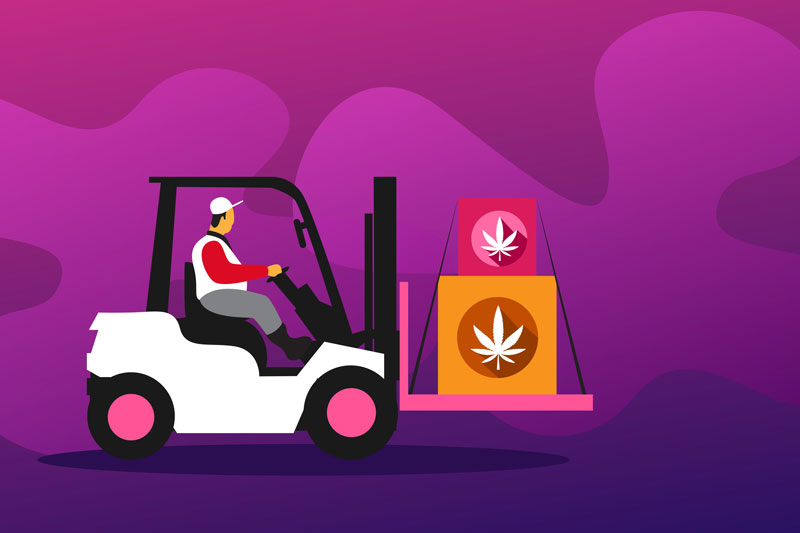The cannabis industry is rapidly expanding, with more and more states legalizing cannabis for both medicinal and recreational use. As new dispensaries and cultivation facilities pop up around the country, the cannabis distribution supply chain grows increasingly complex. Product shelf life, regulations, and the standard obstacles expected from any new industry have posed major obstacles to getting cannabis on store shelves. As a result, efficient supply chain management is growing increasingly important within the industry.
Data analytics platforms, such as Dimensional Insight’s CannaBI Analytics, can provide the supply chain insights that your business needs to answer the important questions such as:
- How do we align supply with demand?
- How do we meet compliance?
- How do we manage multiple channels?
- And, most importantly, how do we increase sales?
Supplier transparency
Cultivation facilities form the backbone of the cannabis industry and are ultimately responsible for determining which products hit store shelves. But without proper transparency, your manufacturing and retail customers can’t plan ahead.
For extract manufacturers, yield (and, in turn, profit margins) are determined entirely by the quality and strain of the flower entering their labs. With supply chain visibility, you can forecast how much extract you’ll be able to produce as well as create marketing efforts for specific strains. Furthermore, purchasers can evaluate other potential sources to help them meet quotas.
This also applies to other businesses located further down the supply chain, such as distributors and retailers. With supplier data-transparency, you can adapt your strategies to coincide with anticipated product availability.

Inventory management
Effective inventory management is crucial to the success of any business, and cannabis is no exception. By using analytics to forecast demand, you can ensure you’re ordering the right amount of product at the right time to avoid overstocks and stockouts.
Furthermore, as a perishable product, cannabis can’t stay on shelves too long. With analytics, you can evaluate which products need to be sold first to avoid throwing out excess inventory. This could be as simple as pushing older products to the front of the shelf or creating promotions to incentivize purchasing a specific batch or line.
Data analytics can also evaluate trends regarding your inventory, such as whether specific products or brands are consistently performing poorly. With this information, you can determine whether they should be prioritizing other products when it comes to future restocks and production efforts.
Vertically integrated businesses
The cannabis industry is already very complex with just one facility. That complexity is compounded with each other facility opened and is further compounded with each different type of facility. Managing multiple areas of cultivation, manufacturing, distribution, and retail opens up a whole new set of financial and regulatory challenges for businesses to keep track of.
In order to keep things running smoothly, upper management needs to know:
- How much of a product they have
- Where it’s going
- Where it’s at
- How much it costs
- How all of that translates to their overarching goals
Unfortunately, a lot of this data is trapped in siloes at every stage of the supply-chain, making it nearly impossible to see the big picture. Making this data useful requires more than the built-in options found in your standard POS software—you need a
Logistics
Logistics is a critical component of the cannabis supply chain, with transportation costs and delivery times having a significant impact on profitability. Cannabis products change hands many times before they reach store shelves, with the risk of something going astray compounding each step of the way. Simply put, the more times a product changes handlers, the more expensive its transportation will be.
With analytics, you can optimize both your schedules and cargo holds, allowing for more product to be delivered in a shorter amount of time. This can seriously reduce wasted spending and allow you to process more product and in turn, increase profitability.
Furthermore, data analytics can assist with cost analysis, allowing you to evaluate weak links in the supply chain and potential opportunities for improvement.

Compliance
Compliance is a key concern in the cannabis industry, with businesses needing to ensure that they meet regulatory requirements at every stage of the supply chain. Compliance organizations, such as Metrc, utilize data analytics to track how and where products move along the supply chain.
Likewise, your business can employ your own analytics to track compliance-related measures to ensure that your operations coincide with established guidelines. Regulatory infractions and failed audits can mean huge fees, something you may not be able to afford in an already very competitive industry.
Learn more
The use of analytics in the cannabis supply chain is quickly growing from a convenience to a necessity. The industry’s current rate of growth means you may have to start taking into account data that goes beyond your POS or ecommerce system and take steps to look at the big picture.
Understanding what your supply chain looks like and what that means for your business is the key to long-term sustainability in the industry, and this is only possible with an end-to-end analytics solution.
Curious what else analytics can do for your cannabis business? Check out our CannaBI Analytics platform.
- How Spirits Brands Can Improve Brand Loyalty with Data Analytics - January 30, 2024
- The Collapse of Herbl, and How Other Cannabis Distributors Can Avoid the Same Fate - January 24, 2024
- Top 5 Blog Posts of 2023 - December 28, 2023




